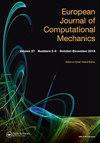Force Characteristics and Mechanical Topology Optimization of Hydraulic Machine Structures: Statics and Dynamics
IF 0.6
Q3 MECHANICS
引用次数: 0
Abstract
In this paper, the design requirements of the hydraulic testing machine are based on the actual force conditions. Static and dynamic performance analyses of the stressed components of the hydraulic machine are carried out and the mechanical topology is optimized. Combining the static and dynamic objective functions of the structure, a fast variable density topology method is proposed, thus improving the optimization efficiency. After setting the positions of the optimized and non-optimized regions. It can be found that the optimized mechanical performance is more superior as the number of iterations increases. The results show that the stress in the strut is 175.75 MPa and the maximum stress in the upper beam structure is 43.708 MPa. The first sixth order frequency is much higher than the operating frequency of 3 Hz. The final results of the mechanical topology optimization analysis show. The optimized structure of the upper, middle and lower crossbeams resulted in a mass reduction of 38%, 36% and 5.57%. The maximum stresses in the upper and middle crossbeams were reduced by 10.33%, 8.3% and 51.8%, respectively. The deformation was reduced by 6.14% at the fastest time; the inherent frequency of the first 3 orders was increased to achieve light weight. The overall mechanical properties became better after optimization, and the dynamic and static stability of the frame was improved. Translated with www.DeepL.com/Translator (free version)液压机械结构的力特性与机械拓扑优化:静力学与动力学
在本文中,液压试验机的设计要求是基于实际受力情况。对液压机受力部件进行了静、动态性能分析,并对其机械拓扑结构进行了优化。结合结构的静态和动态目标函数,提出了一种快速变密度拓扑方法,提高了优化效率。设置优化区域和非优化区域的位置后。可以发现,随着迭代次数的增加,优化后的力学性能更加优越。结果表明:支杆处的应力为175.75 MPa,上部梁结构处的最大应力为43.708 MPa;第一个六阶频率远高于3hz的工作频率。最后的力学拓扑优化分析结果显示。优化后的上、中、下横梁的质量分别减少38%、36%和5.57%。上、中横梁的最大应力分别降低了10.33%、8.3%和51.8%。在最快的时间内,变形减少了6.14%;增加了前3阶的固有频率以实现轻量化。优化后的车架整体力学性能得到改善,动、静稳定性得到提高。由www.DeepL.com/Translator翻译(免费版)
本文章由计算机程序翻译,如有差异,请以英文原文为准。
求助全文
约1分钟内获得全文
求助全文

 求助内容:
求助内容: 应助结果提醒方式:
应助结果提醒方式:


